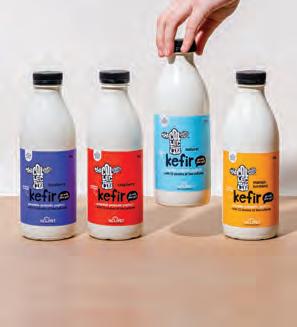
5 minute read
AIP
ANZ Packaging with Post Consumer Recyclate stands out globally
Recent data has indicated that 39 per cent of all packaging used and sold in Australia is currently made from at least 50 per cent recycled content as 2025 sustainable packaging targets near.
Author Nerida Kelton MAIP, Executive Director, Australian Institute of Packaging (AIP), vice president Sustainability & Save Food – WPO
One of the 2025 National Packaging Targets is that all packaging that is made, used and sold in Australia needs to incorporate 50 per cent recycled content. In the latest data report entitled Australian Packaging Consumption and Recycling Data 2019–20 it indicates that 39 per cent of the packaging on the market in our region now incorporates recycled content.
While it is encouraging to see how many companies across the region have been working hard to meet the 50 per cent recycled content target, it is more pleasing to see that two have been recognised for their efforts by receiving 2022 WorldStar Packaging Awards.
The Collective and Squeezepak squeezy sauce bottle are outstanding technical examples of how to incorporate Post-Consumer Recyclate (PCR) into food and beverage packaging.
Incorporating post-consumer recycled content is an important piece of the circular design puzzle as it means brands can reduce the percentage of virgin materials used in their packaging. This in turn will see less burden on natural resources and reductions in packaging going to landfill, land pollution and marine litter. Packaging that is circular by design also reduces carbon emissions and pollutants in the environment.
The Collective drinking yoghurt
The Collective is an innovative New Zealand business that creates yoghurt. The company wanted to launch the first drinking yoghurt bottle in the region, which incorporated 100 per cent PCR base resin rPET in its packaging.
The Collective challenged its packaging partner, the Pact Group, to maximise the use of recycled content in its packs; all the while achieving the same structural performances of virgin material. To do this, the Pact Group assembled a cross-functional team that included material scientists, technical engineers, industrial designers and packaging specialists to run trials and develop the perfect solution.
By using 100 per cent base resin rPET and light weighting the packaging by 27 per cent, 34.5 tonnes of virgin PET will be saved per annum and The Collective will re-purpose 25.12 tonnes of PCR per annum.
A PIQET (Packaging Impact Quick Evaluation Tool) for The Collective revealed that transitioning from virgin PET to 100 per cent base resin rPET and light weighting by 27 per cent resulted in a reduction in CO2 emissions – saving 98.26 tonnes of CO2 emissions per year - the equivalent to planting 148 trees per year. There were savings of 3.3 million litres of water – the equivalent to 1.35 Olympic size swimming pools – and solid waste savings of 19.97 tonnes per year – the equivalent to the weight of 4.5 African elephants.
The result is The Collective’s 700ml drinkable yoghurt bottle range, across five SKUs, is now made from 100 per cent PCR base resin rPET.
SqueezePak squeezy sauce bottle
The SqueezePak squeezy sauce bottle with 100 per cent food-grade recycled PE is believed to be a first of its kind in the region and is part of Wellman Packaging’s over-arching strategy to becoming ‘better than carbon neutral’ and convert all feedstocks to 100 per cent recycled or renewable content by 2025.
While designing the new SqueezePak sauce bottle, Wellman Packaging addressed other bottle performance improvements, features and processes to deliver multiple technical benefits to the finished packaging design.
The SqueezePak sauce bottle has improved hot filling performance and bottle stability due to a proprietaryreinforced convex base design resulting in reduced panelling of side walls due to negative internal pressures after filling.
The design offers a 12 per cent increased top load strength, a 10 per cent larger brimful volume for easier filling – especially when hot filling – and a 7 per cent larger label panel area for improved on-shelf presence.
Due to the design features, the SqueezePak squeezy sauce bottle weight can be reduced by 9 per cent, or maintained at existing weights for an improved top load performance, depending on customer requirements. For companies who prefer the coloured bottle, the consumption of pigments (delivered by masterbatch additives), has been reduced by 50 per cent because of the concentration of pigment into the outer layer of the extruded bottle, and by the application of multi-layer extrusion technology. The SqueezePak sauce bottle can also be produced in a translucent format with reasonable contact clarity bottle, i.e.: without colourant, to expand the reuse of recovered raw materials.
The AIP encourages companies that are meeting the 50 per cent recycled content targets to communicate this to customers on and off-pack. Marketing departments need to communicate how much material has been reduced through light weighting, how much virgin material has been saved through the new design, what percentage of PCR content has been incorporated into the pack, and whether the PCR is locally sourced.
Customers want to see that the packaging they purchase is circular by design and the brands they are loyal to are lowering their environmental impacts wherever possible.
Next time you are wandering down a supermarket aisle have a look for brands that effectively communicate on, and off pack, how much recycled content is used and what messaging they offer consumers around the overall sustainability objectives of the business. These are the brands that are working hard to meet the 2025 National Packaging Targets, to minimise their environmental footprint across all areas of their business and to make sure that their customers understand the milestones they have reached along the way, as well as the next milestones to come. F











